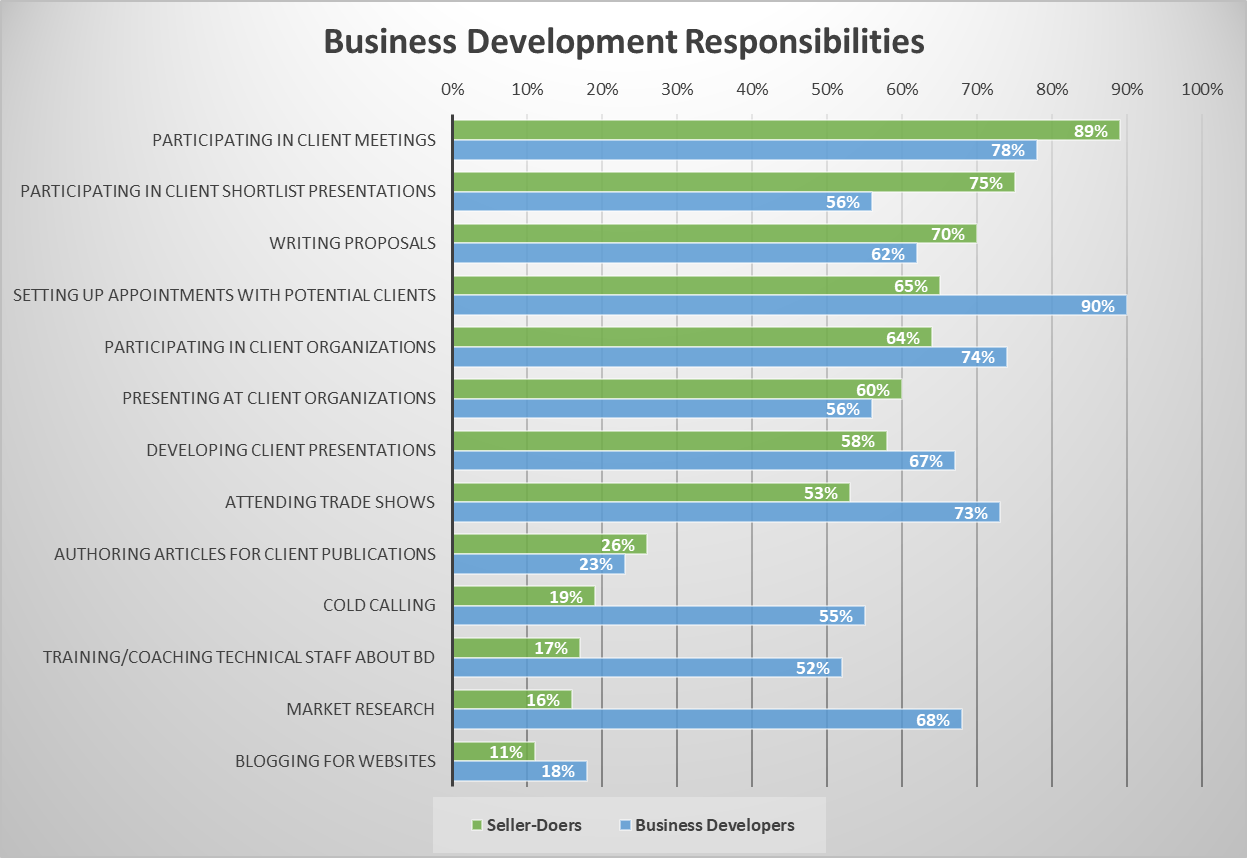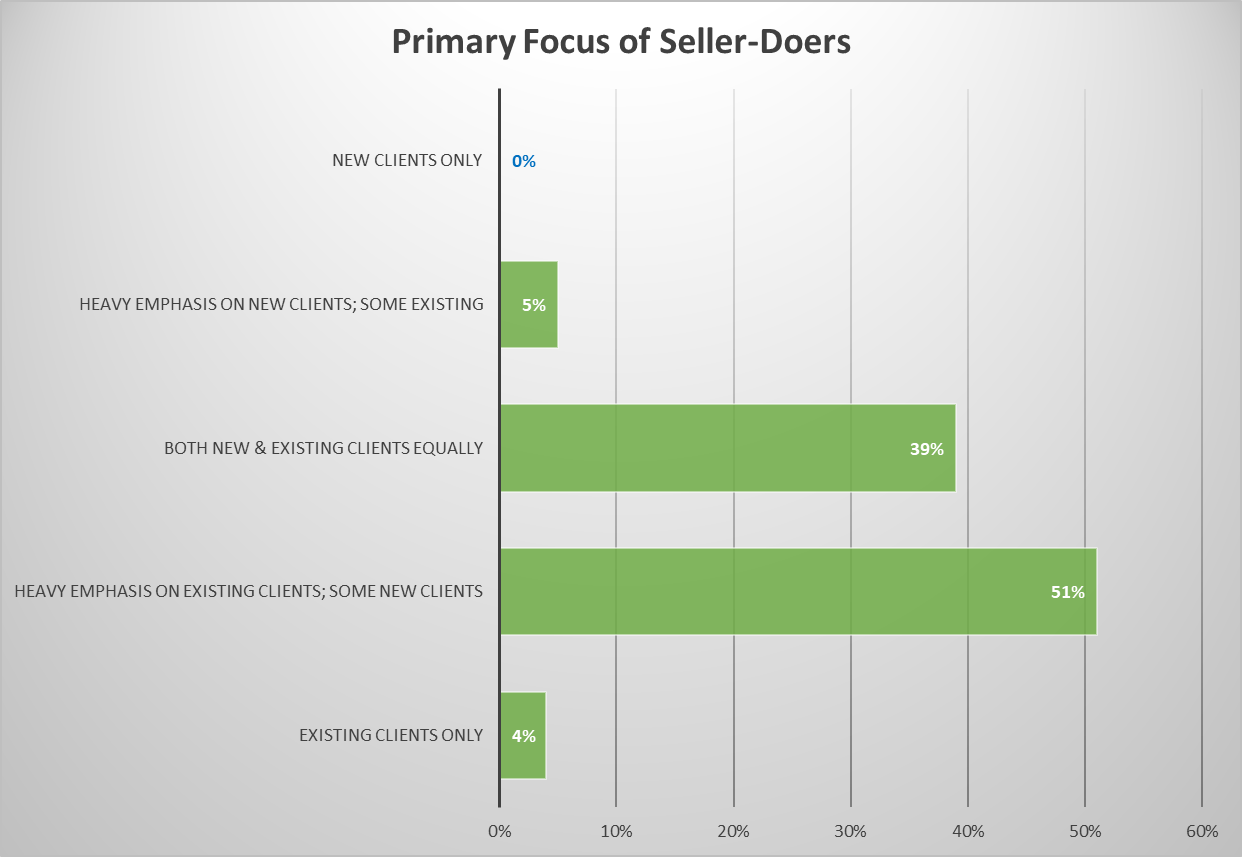Once upon a time, in the twentieth century, the architecture, engineering, and construction industry deemed “sell” a four-letter world, and attempted to ban it from the A/E/C vernacular. Likewise, its derivates like “sales” and “selling” were deemed Words that Cannot be Said Aloud, and the euphemism “business development” was adopted in its place. Of course, in some firms “business development” is also a naughty word, replaced with the seemingly more palatable “client development” or “client services.”
Yet, without sales, there is no business. Without selling, a firm cannot grow, much less sustain their size. And at the end of the day, anyone in a client-facing or prospect-facing role is in sales, whether they want to admit it or not. In fact, everyone plays a vital role in sales – even the back-office person who does great work but never interacts with clients or prospects. In an industry where 80% of workload is often from repeat clients, a single quality issue can torpedo a relationship and result in lost sales.
Sell, selling, and sales are necessary to the very existence of our firms.
Much has been written about the Seller-Doer model, including a post I wrote a few years ago about coming up with a better term than seller-doer!
However, the industry has generally adopted “seller-doer” as a function (sometimes called closer-doer or doer-seller), but not a title. Nor should it ever be a title: it is a responsibility of someone who balances billable work with some sort of business development effort.
Far too often, technical professionals in the A/E/C industry view cold calling and business development as synonymous, which couldn’t be further from the truth. There are a host of tools used by seller-doers and business developers: some overlap, others don’t.
See Seller-Doer Tools, Part 1 and Seller-Doer Tools, Part 2.
Dedicated salespeople – or dedicated business developers in the A/E/C vernacular – provide exceptional value to their firms when they are used correctly. Putting them on wild goose chases because of poor go/no-go decision-making for clients and proposals, or having them focus on “new” markets for which your firm has absolutely no credentials, can be an utter waste of time and money! But when business development is approached strategically, the value these professionals provide to their firms can be game-changing.
However, there aren’t enough dedicated business developers in the A/E/C industry. And the talent shortage is making it more difficult to find them. Unfortunately, I’ve heard too many stories lately about firms foregoing senior business developers – with decades of experience and deep databases of contacts and relationships – for inexperienced business developers, new to the industry. Don’t get me wrong – these “new” industry professionals are vital for the future; yet, their ability to provide instant value is limited as they need to learn the industry and develop relationship from scratch. However, I’ve personally seen how seasoned business developers from other industries have successfully hit the ground running after transitioning to the A/E/C market space. But relationship-building takes time and a lot of proactive effort.
Seller-doers, on the other hand, already have relationships in place. Typical titles for seller-doers are vice president, principal, partner, project manager, project executive, lead designer, lead engineer, etc. These are client-facing positions where interaction throughout the duration of a project is relatively nonstop. And since approximately 80% of an A/E/C firm’s business comes through existing or past clients, the importance of the seller-doer in driving this revenue cannot be understated. Conversely, dedicated business developers typically focus much of their time on creating relationships and uncovering opportunities with new clients.
The Society for Marketing Professional Services (SMPS) and SMPS Foundation conducted a major study of business development practices by A/E/C firms, with almost 1400 quantitative surveys and more than 40 qualitative interviews – half with seller-doers, half with business developers.
The study found that, although there is overlap in responsibilities and techniques between seller-doers and business developers, there are notable differences as well.
The research reinforces the critical importance of the seller-doer model – which more than three-quarters of surveyed firms utilize – as well as the value that dedicated business developers provide to their firms. In smaller firms, use of seller-doers is often the only option, with the principals/owners wearing multiple hats – tasked with getting the work, managing the work, and doing the work! In mid-size and large firms, dedicated business developers are more common.
And while the perception is that many firms don’t utilize business developers because they can’t afford them, the top reason that firms use seller-doers is actually related to client expectations. Seventy percent of survey participants noted that the number one reason for using the seller-doer model is “client expectations to meet with individuals who would work on their project.” In fact, only 13% of firms indicated that they are unable to afford full-time business developers. Another 8% noted that there are not enough business developers available, although if the survey were conducted today, I have no doubt that figure would be higher.
So what does a seller-doer do, besides billable work? The SMPS research queried participants on the responsibilities and activities of seller-doers and dedicated business developers. The table below summarizes the findings:

Seller-doers plug in at multiple places in the sales continuum. In firms with both dedicated business developers and seller-doers, the BD professionals are more often the door openers, while the seller-doers are the closers. When looking at this data, keep in mind that it includes firms with only seller-doers, only business developers, or a combination of both models. Seller-doers often become engaged once an opportunity has been identified, participating in meetings with clients (and prospective clients), writing proposals, and participating in project interviews.
Conversely, dedicated business developers are on the front-end of opportunities and outreach, attending trade shows, participating in client organizations, conducting market research, and setting up appointments – which they typically also attend.
But seller-doers have to cold call, right?
According to the SMPS research, only 19% of seller-doers actually cold call – compared with slightly more than half of business developers. In fact, cold calling is merely the 10th most common responsibility of business developers.
The table below looks at how seller-doers focus their business development activities:

The SMPS research revealed that no seller-doers focus exclusively on developing business with new clients. And only 5% of respondents indicated the seller-doers at their firms focus primarily on new clients, conducting limited business development with existing clients.
Conversely, very few seller-doers focus exclusively on existing clients – only 4%. Rather, the most common response to the question of where seller-doers spend their BD time, with slightly more than half of respondents, is a heavy emphasis on existing clients, with limited time spent on developing new clients. Furthermore, just under 40% of seller-doer doers tracked in the research spent an equal amount of time developing new and existing client relationships.
What does this mean?
It means that it is time to rethink what a seller-doer is and what one does.
Seller-doers are primarily focused on cultivating existing relationships, identifying forthcoming opportunities with their clients, cross-selling services, and looking to work at different locations with the same client. They work in tandem with business developers in firms that use both models, and play the role of technical seller and closer.
In firms with no dedicated business development staff, the seller-doers are on the front lines of new business acquisition while maintaining and expanding relationships with existing clients.
A/E/C firms need to move beyond viewing “sell” as a four-letter word, and embrace the value that seller-doers can offer. They also need to elevate the sales-related skills of the seller-doers, and many firms already have in-house resources for training: dedicated business developers on staff. Slightly more than half of dedicated business developers already provide sales training and coaching to technical staff, and over the past few years it seems, at least anecdotally, that A/E/C firms are increasingly relying on this approach to enhance the skill set of their seller-doers.
It’s time to rethink the sales function in your company, embrace the diverse and critically important skills of your business developers and seller-doers, and focus BD responsibilities for these positions where they will have the greatest impact to your firm!
Interested in learning more about the Society for Marketing Professional Services? Surf to www.smps.org. SMPS has made available a free 32-page report summarizing the research, which can be downloaded here.


Post a comment to this article
Report Abusive Comment